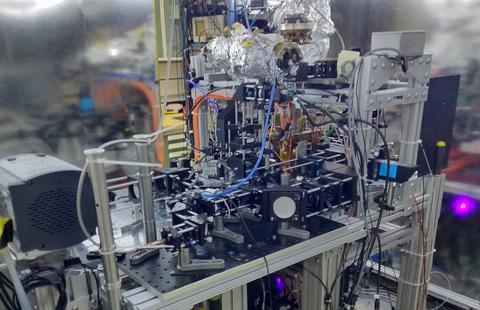Summary
Measurement. Science is rooted in measurement: it is from measurements, as unified by theory, that understanding is born. Our comprehension of the universe is therefore bounded by our ability to observe and shaped by human creativity. Scientific progress is driven by the identification of new physical systems and measurement techniques, leading to new conceptual understanding. Our experiments use systems of ultracold neutral atoms, quantum gases, that make quantum physics manifest in the laboratory. Many properties of these systems can be understood in the intellectual context of many-body physics which describes systems from the commonplace such as crystals, fluids, and semiconductors, to the extreme such as superconductors, quantum Hall systems, and neutron stars. Many-body physics asks how the properties of individual components — atoms, electrons, nucleons — give rise to the observed macroscopic phenomena.
Description

The RbChip experiment was born to drive spin-dependent forces on the wavelength scale, but has developed as a versatile platform that has engineered a Yang monopole, created 1D Bose gases, and developed new imaging techniques to realize open quantum systems. Today this experiment is creating sub-wavelength disorder for spin-orbit coupled BECs, subjecting cold atoms to repeated weak measurement with classical feedback and making holograms from cold atom systems.
Ultracold atoms are a very different sort of system than conventional materials, composed of a few hundred to a few hundred million atoms, with densities ranging from 1012 cm-3 to 1015 cm-3, and at temperatures from below 1 nK to a couple uK. These atomic systems are unique in the simplicity of their underlying Hamiltonian along with a singular capacity for controlling and engineering their quantum degrees of freedom.
Our experiments — inspired by the on-going theory efforts of our collaborators world-wide — take place on three distinct apparatuses: RbK, focusing on artificial gauge fields for atomic Bose and Fermi gases; RbChip, creating spin-dependent forces without light; and RbLi, designing long range interactions mediated by particle exchange.
In addition in collaboration with Dr. Justyna Zwolak in the Information Technology Laboratory at NIST, we are exploring the application of machine learning to control, analysis and exploration in quantum experiments.
Postdoc fellowship openings. Postdoc applications are always welcome! For fellowship options, consider: the JQI Experimental postdoc program (Applications due in Feb.); NIST NRC postdoc program: candidates must be US citizens within 5 years of Ph.D. (Applications will be due in Feb. and Aug. Candidates with an interest in experiment should contact Spielman while those with an interest in machine learning should contact Zwolak). In all cases, contact should be made well in advance of these deadlines.

